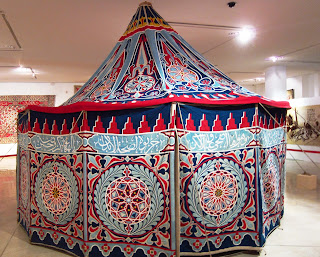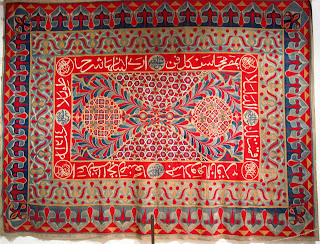Described as “the Egyptian art of tent-making”,
Khayamiya (خيّامية) were used as doorways, canopies, or decorative walls. These beautiful textiles with geometric Islamic designs were first documented in photographs during the Khedival period (1867 – 1914), when Egypt was a state within the Ottoman Empire. It is a dying tradition within Egypt, where pieces from the early 20th century are now preserved in collections found in “…farms in Alaska, country estates in the UK, and weddings in rural Australia”.
Exhibited works include ‘The Thatcher Panel’ and ‘The Rhode Island Panel’, which large sizes indicate that it may have adorned ceilings. Contemporary creations are smaller and more obviously decorative, although the reason behind its popularity decline is not clear.
 |
| Installation view of the Ceremonial Tent (c. 1900–1910) |
Islamic designs typically employ cubic perspectives, where geometric and natural patterns overlay each plane with no clear beginning and end. Repeated patterns on the ‘Ceremonial Tent’ make for a magnificent sight, although the museum’s decision to display the tent inside-out is questionably effective. The exhibition
curator proposes that the paper cut-outs of
Henri Matisse – being an avid collector of Islamic textiles – were influenced by the hand appliqué technique of
khayamiya. Regardless, the older exhibits present wonderfully composed combinations of form and colour, and one can only imagine that Matisse’s impulse was to strip these forms of its hierarchy and make it dance.
 |
| An exhibit in “Khayamiya: Khedival to Contemporary” |
Comments
Post a Comment